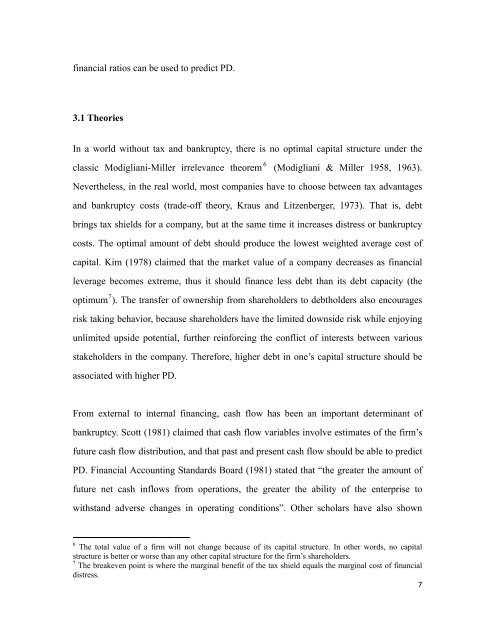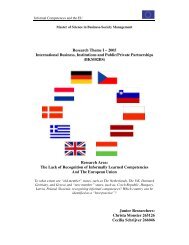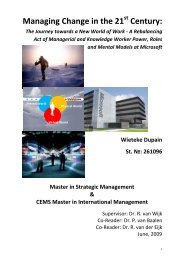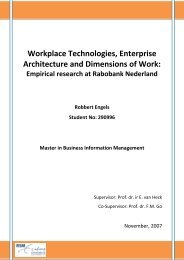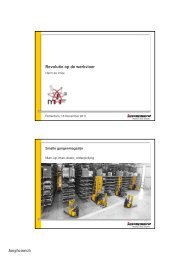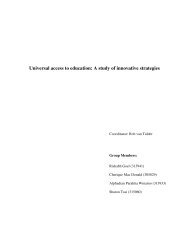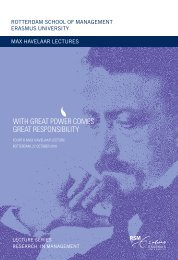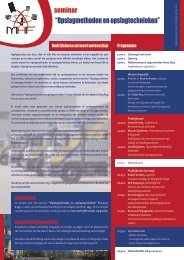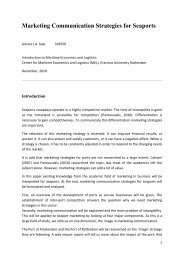Financial Ratios as Predictors of Failure: Evidence from ... - ERIM
Financial Ratios as Predictors of Failure: Evidence from ... - ERIM
Financial Ratios as Predictors of Failure: Evidence from ... - ERIM
You also want an ePaper? Increase the reach of your titles
YUMPU automatically turns print PDFs into web optimized ePapers that Google loves.
financial ratios can be used to predict PD.<br />
3.1 Theories<br />
In a world without tax and bankruptcy, there is no optimal capital structure under the<br />
cl<strong>as</strong>sic Modigliani-Miller irrelevance theorem 6 (Modigliani & Miller 1958, 1963).<br />
Nevertheless, in the real world, most companies have to choose between tax advantages<br />
and bankruptcy costs (trade-<strong>of</strong>f theory, Kraus and Litzenberger, 1973). That is, debt<br />
brings tax shields for a company, but at the same time it incre<strong>as</strong>es distress or bankruptcy<br />
costs. The optimal amount <strong>of</strong> debt should produce the lowest weighted average cost <strong>of</strong><br />
capital. Kim (1978) claimed that the market value <strong>of</strong> a company decre<strong>as</strong>es <strong>as</strong> financial<br />
leverage becomes extreme, thus it should finance less debt than its debt capacity (the<br />
optimum 7 ). The transfer <strong>of</strong> ownership <strong>from</strong> shareholders to debtholders also encourages<br />
risk taking behavior, because shareholders have the limited downside risk while enjoying<br />
unlimited upside potential, further reinforcing the conflict <strong>of</strong> interests between various<br />
stakeholders in the company. Therefore, higher debt in one’s capital structure should be<br />
<strong>as</strong>sociated with higher PD.<br />
From external to internal financing, c<strong>as</strong>h flow h<strong>as</strong> been an important determinant <strong>of</strong><br />
bankruptcy. Scott (1981) claimed that c<strong>as</strong>h flow variables involve estimates <strong>of</strong> the firm’s<br />
future c<strong>as</strong>h flow distribution, and that p<strong>as</strong>t and present c<strong>as</strong>h flow should be able to predict<br />
PD. <strong>Financial</strong> Accounting Standards Board (1981) stated that “the greater the amount <strong>of</strong><br />
future net c<strong>as</strong>h inflows <strong>from</strong> operations, the greater the ability <strong>of</strong> the enterprise to<br />
withstand adverse changes in operating conditions”. Other scholars have also shown<br />
6<br />
The total value <strong>of</strong> a firm will not change because <strong>of</strong> its capital structure. In other words, no capital<br />
structure is better or worse than any other capital structure for the firm’s shareholders.<br />
7<br />
The breakeven point is where the marginal benefit <strong>of</strong> the tax shield equals the marginal cost <strong>of</strong> financial<br />
distress.<br />
7


